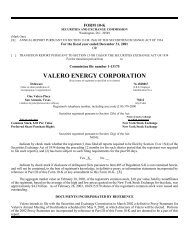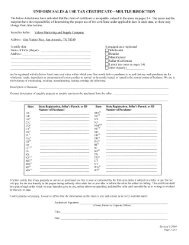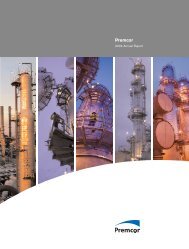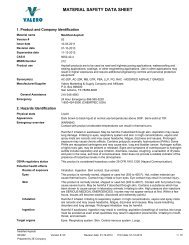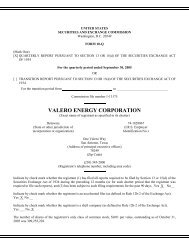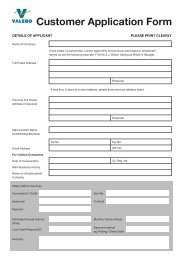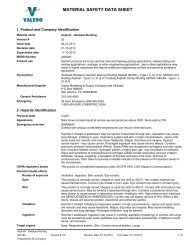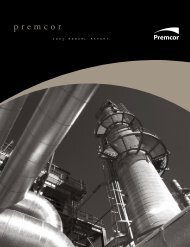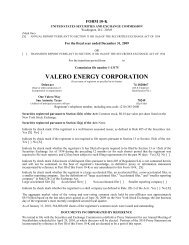Aromatic Concentrate-420 - Valero
Aromatic Concentrate-420 - Valero
Aromatic Concentrate-420 - Valero
You also want an ePaper? Increase the reach of your titles
YUMPU automatically turns print PDFs into web optimized ePapers that Google loves.
MATERIAL SAFETY DATA SHEET<br />
1. Product and Company Identification<br />
Material name<br />
Version # 03<br />
Issue date 04-04-2011<br />
Revision date 11-13-2012<br />
Supersedes date 09-28-2012<br />
MSDS Number <strong>420</strong><br />
Product use<br />
Synonym(s)<br />
Manufacturer/Supplier<br />
General Assistance<br />
<strong>Aromatic</strong> <strong>Concentrate</strong><br />
Refinery feedstock.<br />
Benzene <strong>Concentrate</strong>. MSAT Product. Reformer <strong>Concentrate</strong>. Benzene/toluene <strong>Concentrate</strong>.<br />
Heart cut <strong>Concentrate</strong>.<br />
See section 16 for complete information.<br />
<strong>Valero</strong> Marketing & Supply Company and Affiliates<br />
P.O. Box 696000<br />
San Antonio, TX 78269-6000<br />
210-345-4593<br />
Emergency 24 Hour Emergency 866-565-5220<br />
1-800-424-9300 (CHEMTREC USA)<br />
2. Hazards Identification<br />
Physical state<br />
Appearance<br />
Emergency overview<br />
OSHA regulatory status<br />
Potential health effects<br />
Routes of exposure<br />
Eyes<br />
Skin<br />
Inhalation<br />
Ingestion<br />
Target organs<br />
Chronic effects<br />
<strong>Aromatic</strong> <strong>Concentrate</strong><br />
900670<br />
Prepared by 3E Company<br />
Liquid.<br />
Version #: 03<br />
Colorless to orange liquid.<br />
DANGER!<br />
Extremely flammable liquid and vapor - vapor may cause flash fire. Will be easily ignited by heat,<br />
spark or flames. Heat may cause the containers to explode.<br />
Harmful if inhaled, absorbed through skin, or swallowed. Aspiration may cause lung damage.<br />
Irritating to eyes, respiratory system and skin. In high concentrations, vapors and spray mists are<br />
narcotic and may cause headache, fatigue, dizziness and nausea. Contains benzene. Hydrogen<br />
sulfide, a highly toxic gas, may be present or released. Signs and symptoms of overexposure to<br />
hydrogen sulfide include respiratory and eye irritation, dizziness, nausea, coughing, a sensation of<br />
dryness and pain in the nose, and loss of consciousness. Odor does not provide a reliable<br />
indicator of the presence of hazardous levels in the atmosphere. Cancer hazard. Mutagen. May<br />
cause heritable genetic damage. May cause adverse reproductive effects - such as birth defects,<br />
miscarriages, or infertility. Prolonged exposure may cause chronic effects. Toxic to aquatic<br />
organisms. May cause long-term adverse effects in the aquatic environment.<br />
This product is considered hazardous under 29 CFR 1910.1200 (Hazard Communication).<br />
Inhalation. Ingestion. Skin contact. Eye contact.<br />
Contact may irritate or burn eyes. Eye contact may result in corneal injury.<br />
Harmful if absorbed through skin. Irritating to skin. Frequent or prolonged contact may defat and<br />
dry the skin, leading to discomfort and dermatitis.<br />
Harmful if inhaled. Irritating to respiratory system. In high concentrations, vapors and spray mists<br />
are narcotic and may cause headache, fatigue, dizziness and nausea. May cause breathing<br />
disorders and lung damage. May cause cancer by inhalation. Prolonged inhalation may be<br />
harmful.<br />
Harmful if swallowed. Ingestion may result in vomiting; aspiration (breathing) of vomitus into lungs<br />
must be avoided as even small quantities may result in aspiration pneumonitis. Irritating to mouth,<br />
throat, and stomach.<br />
Blood. Eyes. Liver. Respiratory system. Skin. Kidneys. Central nervous system.<br />
Cancer hazard. Contains material which may have reproductive toxicity, teratogenetic or<br />
mutagenic effects. Liver injury may occur. Kidney injury may occur. May cause central nervous<br />
system disorder (e.g., narcosis involving a loss of coordination, weakness, fatigue, mental<br />
confusion and blurred vision) and/or damage. Frequent or prolonged contact may defat and dry<br />
the skin, leading to discomfort and dermatitis.<br />
Revison date: 11-13-2012 Print date: 11-13-2012<br />
CPH MSDS NA<br />
1 / 12
Signs and symptoms<br />
Potential environmental effects<br />
Irritation of nose and throat. Irritation of eyes and mucous membranes. Skin irritation.<br />
Unconsciousness. Corneal damage. Narcosis. Cyanosis (blue tissue condition, nails, lips, and/or<br />
skin). Decrease in motor functions. Behavioral changes. Edema. Liver enlargement. Jaundice.<br />
Conjunctivitis. Proteinuria. Defatting of the skin. Rash.<br />
Toxic to aquatic organisms. May cause long-term adverse effects in the aquatic environment.<br />
3. Composition / Information on Ingredients<br />
Components CAS # Percent<br />
Benzene<br />
Toluene<br />
C5 - C9 Nonaromatic hydrocarbons<br />
Ethylbenzene<br />
Xylene (o, m, p isomers)<br />
Hydrogen sulfide<br />
71-43-2 15 - 65<br />
108-88-3 15 - 30<br />
Mixture 0 - 30<br />
100-41-4 0 - 10<br />
1330-20-7 0 - 10<br />
7783-06-4 0 - 1<br />
Composition comments<br />
Small amount of hydrogen sulfide, a highly toxic gas, may be present, especially in the headspace<br />
of containers.<br />
4. First Aid Measures<br />
First aid procedures<br />
Eye contact<br />
Skin contact<br />
Inhalation<br />
Ingestion<br />
Notes to physician<br />
General advice<br />
Immediately flush eyes with plenty of water for at least 15 minutes. Remove contact lenses, if<br />
present and easy to do. Continue rinsing. Get medical attention.<br />
Remove contaminated clothing and shoes. Wash off immediately with soap and plenty of water.<br />
Get medical attention if irritation develops or persists. Wash clothing separately before reuse.<br />
Destroy or thoroughly clean contaminated shoes. If high pressure injection under the skin occurs,<br />
always seek medical attention.<br />
Move to fresh air. If breathing is difficult, give oxygen. If not breathing, give artificial respiration.<br />
Get medical attention.<br />
Rinse mouth thoroughly. Do not induce vomiting without advice from poison control center. Do not<br />
give mouth-to-mouth resuscitation. If vomiting occurs, keep head low so that stomach content<br />
does not get into the lungs. Get medical attention immediately.<br />
In case of shortness of breath, give oxygen. Keep victim warm. Keep victim under observation.<br />
Symptoms may be delayed.<br />
If exposed or concerned: get medical attention/advice. Ensure that medical personnel are aware<br />
of the material(s) involved, and take precautions to protect themselves. Show this safety data<br />
sheet to the doctor in attendance. Wash contaminated clothing before re-use.<br />
5. Fire Fighting Measures<br />
Flammable properties<br />
Extinguishing media<br />
Suitable extinguishing<br />
media<br />
Unsuitable extinguishing<br />
media<br />
Protection of firefighters<br />
Specific hazards arising<br />
from the chemical<br />
Protective equipment and<br />
precautions for firefighters<br />
Flammable by OSHA criteria. Containers may explode when heated.<br />
Water spray. Water fog. Foam. Dry chemical powder. Carbon dioxide (CO2).<br />
Do not use a solid water stream as it may scatter and spread fire.<br />
Vapor may cause flash fire. Vapors can flow along surfaces to distant ignition source and flash<br />
back. Sensitive to static discharge.<br />
Wear full protective clothing, including helmet, self-contained positive pressure or pressure<br />
demand breathing apparatus, protective clothing and face mask.<br />
<strong>Aromatic</strong> <strong>Concentrate</strong><br />
900670<br />
Version #: 03<br />
Revison date: 11-13-2012 Print date: 11-13-2012<br />
CPH MSDS NA<br />
2 / 12<br />
Prepared by 3E Company
Fire fighting<br />
equipment/instructions<br />
Specific methods<br />
Hazardous combustion<br />
products<br />
Wear full protective clothing, including helmet, self-contained positive pressure or pressure<br />
demand breathing apparatus, protective clothing and face mask. Withdraw immediately in case of<br />
rising sound from venting safety devices or any discoloration of tanks due to fire. Fight fire from<br />
maximum distance or use unmanned hose holders or monitor nozzles. Move containers from fire<br />
area if you can do it without risk. In the event of fire, cool tanks with water spray. Cool containers<br />
exposed to flames with water until well after the fire is out. For massive fire, use unmanned hose<br />
holders or monitor nozzles; if this is impossible, withdraw from area and let fire burn. Vapors may<br />
form explosive air mixtures even at room temperature. Prevent buildup of vapors or gases to<br />
explosive concentrations. Some of these materials, if spilled, may evaporate leaving a flammable<br />
residue. Water runoff can cause environmental damage. Use compatible foam to minimize vapor<br />
generation as needed.<br />
In the event of fire and/or explosion do not breathe fumes. Use water spray to cool unopened<br />
containers.<br />
Carbon monoxide. Carbon Dioxide. Sulfur oxides. Nitrogen oxides (NOx). Hydrocarbons.<br />
6. Accidental Release Measures<br />
Personal precautions<br />
Environmental precautions<br />
Methods for containment<br />
Methods for cleaning up<br />
Keep unnecessary personnel away. Local authorities should be advised if significant spills cannot<br />
be contained. Keep upwind. Keep out of low areas. Ventilate closed spaces before entering. Do<br />
not touch damaged containers or spilled material unless wearing appropriate protective clothing.<br />
See Section 8 of the MSDS for Personal Protective Equipment.<br />
If facility or operation has an "oil or hazardous substance contingency plan", activate its<br />
procedures. Stay upwind and away from spill. Wear appropriate protective equipment including<br />
respiratory protection as conditions warrant. Do not enter or stay in area unless monitoring<br />
indicates that it is safe to do so. Isolate hazard area and restrict entry to emergency crew.<br />
Flammable. Review Firefighting Measures, Section 5, before proceeding with clean up. Keep all<br />
sources of ignition (flames, smoking, flares, etc.) and hot surfaces away from release. Contain<br />
spill in smallest possible area. Recover as much product as possible (e.g. by vacuuming). Stop<br />
leak if it can be done without risk. Use water spray to disperse vapors. Use compatible foam to<br />
minimize vapor generation as needed. Spilled material may be absorbed by an appropriate<br />
absorbent, and then handled in accordance with environmental regulations. Prevent spilled<br />
material from entering sewers, storm drains, other unauthorized treatment or drainage systems<br />
and natural waterways. Contact fire authorities and appropriate federal, state and local agencies.<br />
If spill of any amount is made into or upon navigable waters, the contiguous zone, or adjoining<br />
shorelines, contact the National Response Center at 1-800-424-8802. For highway or railways<br />
spills, contact Chemtrec at 1-800-424-9300.<br />
Eliminate all ignition sources (no smoking, flares, sparks, or flames in immediate area). Stop leak<br />
if you can do so without risk. This material is a water pollutant and should be prevented from<br />
contaminating soil or from entering sewage and drainage systems and bodies of water. Dike the<br />
spilled material, where this is possible. Prevent entry into waterways, sewers, basements or<br />
confined areas.<br />
Use non-sparking tools and explosion-proof equipment.<br />
Small Spills: Absorb spill with vermiculite or other inert material, then place in a container for<br />
chemical waste. Clean surface thoroughly to remove residual contamination. This material and its<br />
container must be disposed of as hazardous waste.<br />
Other information<br />
Large Spills: Use a non-combustible material like vermiculite, sand or earth to soak up the product<br />
and place into a container for later disposal. Prevent product from entering drains. Do not allow<br />
material to contaminate ground water system. Should not be released into the environment.<br />
Clean up in accordance with all applicable regulations.<br />
7. Handling and Storage<br />
Handling<br />
Storage<br />
Wear personal protective equipment. Do not breathe gas/fumes/vapor/spray. Avoid contact with<br />
eyes, skin, and clothing. Do not taste or swallow. Avoid prolonged exposure. Use only with<br />
adequate ventilation. Wash thoroughly after handling. The product is extremely flammable, and<br />
explosive vapor/air mixtures may be formed even at normal room temperatures. DO NOT handle,<br />
store or open near an open flame, sources of heat or sources of ignition. Protect material from<br />
direct sunlight. Take precautionary measures against static discharges. All equipment used when<br />
handling the product must be grounded. Use non-sparking tools and explosion-proof equipment.<br />
When using, do not eat, drink or smoke. Avoid release to the environment.<br />
Flammable liquid storage. Do not handle or store near an open flame, heat or other sources of<br />
ignition. This material can accumulate static charge which may cause spark and become an<br />
ignition source. The pressure in sealed containers can increase under the influence of heat. Keep<br />
container tightly closed in a cool, well-ventilated place. Keep away from food, drink and animal<br />
feedingstuffs. Keep out of the reach of children.<br />
<strong>Aromatic</strong> <strong>Concentrate</strong><br />
900670<br />
Prepared by 3E Company<br />
Version #: 03<br />
Revison date: 11-13-2012 Print date: 11-13-2012<br />
CPH MSDS NA<br />
3 / 12
8. Exposure Controls / Personal Protection<br />
Occupational exposure limits<br />
US. ACGIH Threshold Limit Values<br />
Components<br />
Benzene (CAS 71-43-2)<br />
Ethylbenze ne (CAS<br />
100-41-4)<br />
Hydrogen sulfide (CAS<br />
7783-06-4)<br />
Toluene (CAS 108-88-3)<br />
Xylene (o, m, p isomers)<br />
(CAS 1330-20-7)<br />
Type<br />
STEL<br />
TWA<br />
TWA<br />
STEL<br />
TWA<br />
TWA<br />
STEL<br />
TWA<br />
US. OSHA Specifically Regulated Substances (29 CFR 1910.1001-1050)<br />
Components<br />
Type<br />
Benzene (CAS 71-43-2)<br />
STEL<br />
TWA<br />
US. OSHA Table Z-1 Limits for Air Contaminants (29 CFR 1910.1000)<br />
Value<br />
2.5 ppm<br />
0.5 ppm<br />
20 ppm<br />
5 ppm<br />
1 ppm<br />
20 ppm<br />
150 ppm<br />
100 ppm<br />
Value<br />
5 ppm<br />
1 ppm<br />
Components<br />
Ethylbenze ne (CAS<br />
100-41-4)<br />
Xylene (o, m, p isomers)<br />
(CAS 1330-20-7)<br />
US. OSHA Table Z-2 (29 CFR 1910.1000)<br />
Type<br />
PEL<br />
PEL<br />
Value<br />
435 mg/m3<br />
100 ppm<br />
435 mg/m3<br />
100 ppm<br />
Components<br />
Type<br />
Value<br />
Benzene (CAS 71-43-2)<br />
Ceiling<br />
25 ppm<br />
TWA<br />
10 ppm<br />
Hydrogen sulfide (CAS<br />
7783-06-4)<br />
Toluene (CAS 108-88-3)<br />
Ceiling<br />
Ceiling<br />
20 ppm<br />
300 ppm<br />
TWA<br />
200 ppm<br />
Canada. Alberta OELs (Occupational Health & Safety Code, Schedule 1, Table 2)<br />
Components<br />
Benzene (CAS 71-43-2)<br />
Ethylbenze ne (CAS<br />
100-41-4)<br />
Hydrogen sulfide (CAS<br />
7783-06-4)<br />
Toluene (CAS 108-88-3)<br />
Xylene (o, m, p isomers)<br />
(CAS 1330-20-7)<br />
Type<br />
STEL<br />
TWA<br />
STEL<br />
TWA<br />
Ceiling<br />
TWA<br />
TWA<br />
STEL<br />
Value<br />
8 mg/m3<br />
2.5 ppm<br />
1.6 mg/m3<br />
0.5 ppm<br />
543 mg/m3<br />
125 ppm<br />
434 mg/m3<br />
100 ppm<br />
21 mg/m3<br />
15 ppm<br />
14 mg/m3<br />
10 ppm<br />
188 mg/m3<br />
50 ppm<br />
651 mg/m3<br />
150 ppm<br />
<strong>Aromatic</strong> <strong>Concentrate</strong><br />
900670<br />
Prepared by 3E Company<br />
Version #: 03<br />
Revison date: 11-13-2012 Print date: 11-13-2012<br />
CPH MSDS NA<br />
4 / 12
Canada. Alberta OELs (Occupational Health & Safety Code, Schedule 1, Table 2)<br />
Components<br />
Type<br />
TWA<br />
Value<br />
434 mg/m3<br />
100 ppm<br />
Canada. British Columbia OELs. (Occupational Exposure Limits for Chemical Substances, Occupational Health and<br />
Safety Regulation 296/97, as amended)<br />
Components<br />
Benzene (CAS 71-43-2)<br />
Ethylbenze ne (CAS<br />
100-41-4)<br />
Hydrogen sulfide (CAS<br />
7783-06-4)<br />
Toluene (CAS 108-88-3)<br />
Xylene (o, m, p isomers)<br />
(CAS 1330-20-7)<br />
Type<br />
STEL<br />
TWA<br />
TWA<br />
Ceiling<br />
TWA<br />
STEL<br />
TWA<br />
Canada. Ontario OELs. (Control of Exposure to Biological or Chemical Agents)<br />
Components<br />
Benzene (CAS 71-43-2)<br />
Ethylbenze ne (CAS<br />
100-41-4)<br />
Hydrogen sulfide (CAS<br />
7783-06-4)<br />
Toluene (CAS 108-88-3)<br />
Xylene (o, m, p isomers)<br />
(CAS 1330-20-7)<br />
Type<br />
STEL<br />
TWA<br />
STEL<br />
TWA<br />
STEL<br />
TWA<br />
TWA<br />
STEL<br />
TWA<br />
Value<br />
2.5 ppm<br />
0.5 ppm<br />
20 ppm<br />
10 ppm<br />
20 ppm<br />
150 ppm<br />
100 ppm<br />
Value<br />
2.5 ppm<br />
0.5 ppm<br />
125 ppm<br />
100 ppm<br />
15 ppm<br />
10 ppm<br />
20 ppm<br />
150 ppm<br />
100 ppm<br />
Canada. Quebec OELs. (Ministry of Labor - Regulation Respecting the Quality of the Work Environment)<br />
Components<br />
Benzene (CAS 71-43-2)<br />
Ethylbenze ne (CAS<br />
100-41-4)<br />
Hydrogen sulfide (CAS<br />
7783-06-4)<br />
Toluene (CAS 108-88-3)<br />
Xylene (o, m, p isomers)<br />
(CAS 1330-20-7)<br />
Mexico. Occupational Exposure Limit Values<br />
Type<br />
STEL<br />
TWA<br />
STEL<br />
TWA<br />
STEL<br />
TWA<br />
TWA<br />
STEL<br />
TWA<br />
Value<br />
15.5 mg/m3<br />
5 ppm<br />
3 mg/m3<br />
1 ppm<br />
543 mg/m3<br />
125 ppm<br />
434 mg/m3<br />
100 ppm<br />
21 mg/m3<br />
15 ppm<br />
14 mg/m3<br />
10 ppm<br />
188 mg/m3<br />
50 ppm<br />
651 mg/m3<br />
150 ppm<br />
434 mg/m3<br />
100 ppm<br />
Components<br />
Benzene (CAS 71-43-2)<br />
<strong>Aromatic</strong> <strong>Concentrate</strong><br />
900670<br />
Version #: 03<br />
Prepared by 3E Company<br />
Type<br />
Value<br />
STEL<br />
16 mg/m3<br />
Revison date: 11-13-2012 Print date: 11-13-2012<br />
CPH MSDS NA<br />
5 / 12
Mexico. Occupational Exposure Limit Values<br />
Components<br />
Ethylbenze ne (CAS<br />
100-41-4)<br />
Hydrogen sulfide (CAS<br />
7783-06-4)<br />
Toluene (CAS 108-88-3)<br />
Xylene (o, m, p isomers)<br />
(CAS 1330-20-7)<br />
Engineering controls<br />
Personal protective equipment<br />
Eye / face protection<br />
Skin protection<br />
Respiratory protection<br />
General hygiene<br />
considerations<br />
9. Physical & Chemical Properties<br />
Appearance<br />
Physical state<br />
Form<br />
Color<br />
Odor<br />
Odor threshold<br />
pH<br />
Vapor pressure<br />
Vapor density<br />
Boiling point<br />
Melting point/Freezing point<br />
Solubility (water)<br />
Specific gravity<br />
Flash point<br />
<strong>Aromatic</strong> <strong>Concentrate</strong><br />
900670<br />
Prepared by 3E Company<br />
Type<br />
TWA<br />
STEL<br />
TWA<br />
STEL<br />
TWA<br />
TWA<br />
STEL<br />
TWA<br />
Value<br />
5 ppm<br />
3.2 mg/m3<br />
1 ppm<br />
545 mg/m3<br />
125 ppm<br />
435 mg/m3<br />
100 ppm<br />
21 mg/m3<br />
15 ppm<br />
14 mg/m3<br />
10 ppm<br />
188 mg/m3<br />
50 ppm<br />
655 mg/m3<br />
150 ppm<br />
435 mg/m3<br />
100 ppm<br />
Provide adequate general and local exhaust ventilation. Use process enclosures, local exhaust<br />
ventilation, or other engineering controls to control airborne levels below recommended exposure<br />
limits. Use explosion-proof equipment.<br />
Wear safety glasses. If splash potential exists, wear full face shield or chemical goggles.<br />
Wear chemical-resistant, impervious gloves. Full body suit and boots are recommended when<br />
handling large volumes or in emergency situations. Flame retardant protective clothing is<br />
recommended.<br />
Use a properly fitted, air-purifying or air-fed respirator complying with an approved standard if a<br />
risk assessment indicates this is necessary. Respirator selection must be based on known or<br />
anticipated exposure levels, the hazards of the product and the safe working limits of the selected<br />
respirator. If workplace exposure limits for product or components are exceeded, NIOSH<br />
approved equipment should be worn. Proper respirator selection should be determined by<br />
adequately trained personnel, based on the contaminants, the degree of potential exposure and<br />
published respiratory protection factors. This equipment should be available for nonroutine and<br />
emergency use.<br />
Consult supervisor for special handling instructions. Avoid contact with eyes. Avoid contact with<br />
skin. Keep away from food and drink. Wash hands before breaks and immediately after handling<br />
the product. Provide eyewash station and safety shower. Handle in accordance with good<br />
industrial hygiene and safety practice.<br />
Colorless to orange liquid.<br />
Liquid.<br />
Liquid.<br />
Version #: 03<br />
Colorless to orange.<br />
<strong>Aromatic</strong>.<br />
Not available.<br />
Not available.<br />
Not available.<br />
Not available.<br />
Not available.<br />
-94.7 °F (-70.41 °C) Estimated<br />
Very slightly soluble.<br />
Not available.<br />
Not available.<br />
Revison date: 11-13-2012 Print date: 11-13-2012<br />
CPH MSDS NA<br />
6 / 12
Flammability limits in air,<br />
upper, % by volume<br />
Flammability limits in air,<br />
lower, % by volume<br />
Auto-ignition temperature<br />
8 %<br />
1 %<br />
Not available.<br />
Percent volatile Essentialy 100%<br />
10. Chemical Stability & Reactivity Information<br />
Chemical stability<br />
Conditions to avoid<br />
Incompatible materials<br />
Hazardous decomposition<br />
products<br />
Possibility of hazardous<br />
reactions<br />
11. Toxicological Information<br />
Toxicological data<br />
Components<br />
Ethylbenzene (CAS 100-41-4)<br />
Acute<br />
Dermal<br />
LD50<br />
Oral<br />
LD50<br />
Hydrogen sulfide (CAS 7783-06-4)<br />
Acute<br />
Inhalation<br />
LC50<br />
Toluene (CAS 108-88-3)<br />
Acute<br />
Inhalation<br />
LC50<br />
Oral<br />
LC50<br />
Stable under normal temperature conditions and recommended use.<br />
Heat, flames and sparks. Ignition sources. Contact with incompatible materials. Do not pressurize,<br />
cut, weld, braze, solder, drill, grind or expose empty containers to heat, flame, sparks, static<br />
electricity, or other sources of ignition; they may explode and cause injury or death.<br />
Strong oxidizing agents. Reducing agents. Acids. Alkalis.<br />
Carbon oxides. Sulfur oxides. Nitrogen oxides (NOx). Hydrocarbons.<br />
Hazardous polymerization does not occur.<br />
Species<br />
Rabbit<br />
Rat<br />
Mouse<br />
Rat<br />
Rat<br />
Rat<br />
Xylene (o, m, p isomers) (CAS 1330-20-7)<br />
Acute<br />
Oral<br />
LD50<br />
Sensitization<br />
Acute effects<br />
Local effects<br />
Rat<br />
US. ACGIH Threshold Limit Values<br />
Benzene (CAS 71-43-2)<br />
Test Results<br />
> 5000 mg/kg<br />
5.46 g/kg<br />
> 0.024 mg/l, 960 Minutes<br />
> 0.38 mg/l, 960 Minutes<br />
8000 mg/l, 4 Hours<br />
636 mg/kg<br />
4300 mg/kg<br />
This substance may have a potential for sensitization which may provoke an allergic reaction<br />
among sensitive individuals.<br />
Harmful if inhaled, absorbed through skin, or swallowed. Harmful: may cause lung damage if<br />
swallowed. Irritating to eyes, respiratory system and skin. In high concentrations, vapors and<br />
spray mists are narcotic and may cause headache, fatigue, dizziness and nausea.<br />
Can be absorbed through the skin.<br />
<strong>Aromatic</strong> <strong>Concentrate</strong><br />
900670<br />
Prepared by 3E Company<br />
Version #: 03<br />
Revison date: 11-13-2012 Print date: 11-13-2012<br />
CPH MSDS NA<br />
7 / 12
Chronic effects<br />
Subchronic effects<br />
Carcinogenicity<br />
ACGIH Carcinogens<br />
Benzene (CAS 71-43-2)<br />
Ethylbenzene (CAS 100-41-4)<br />
Toluene (CAS 108-88-3)<br />
Xylene (o, m, p isomers) (CAS 1330-20-7)<br />
IARC Monographs. Overall Evaluation of Carcinogenicity<br />
Benzene (CAS 71-43-2)<br />
Ethylbenzene (CAS 100-41-4)<br />
Toluene (CAS 108-88-3)<br />
Xylene (o, m, p isomers) (CAS 1330-20-7)<br />
US NTP Report on Carcinogens: Known carcinogen<br />
Prolonged and repeated exposure to benzene may cause serious injury to blood forming organs<br />
and is associated with anemia and to the later development of acute myelogenous leukemia<br />
(AML). Toluene has been reported to decrease immunological responses and cause recordable<br />
hearing loss in laboratory animals. Contains organic solvents which in case of overexposure may<br />
depress the central nervous system causing dizziness and intoxication. Danger of serious<br />
damage to health by prolonged exposure. Prolonged or repeated overexposure may cause central<br />
nervous system, kidney, liver, and lung damage.<br />
Subchronic inhalation of benzene by rats produced decreased white blood cell counts, decreased<br />
bone marrow cell activity, increased red blood cell activity and cataracts. Blood disorders may<br />
occur after prolonged inhalation, prolonged skin contact and/or ingestion. Liver and kidney<br />
damage may occur after prolonged and repeated exposure.<br />
A1 Confirmed human carcinogen.<br />
A3 Confirmed animal carcinogen with unknown relevance to<br />
humans.<br />
A4 Not classifiable as a human carcinogen.<br />
A4 Not classifiable as a human carcinogen.<br />
1 Carcinogenic to humans.<br />
2B Possibly carcinogenic to humans.<br />
3 Not classifiable as to carcinogenicity to humans.<br />
3 Not classifiable as to carcinogenicity to humans.<br />
Benzene (CAS 71-43-2)<br />
Known To Be Human Carcinogen.<br />
US. OSHA Specifically Regulated Substances (29 CFR 1910.1001-1050)<br />
Epidemiology<br />
Mutagenicity<br />
Benzene (CAS 71-43-2)<br />
Neurological effects<br />
Reproductive effects<br />
Teratogenicity<br />
Further information<br />
Cancer hazard.<br />
Contains benzene. Human epidemiology studies indicate that prolonged and/or repeated<br />
overexposure to benzene may cause damage to the blood-producing system and serious blood<br />
disorders, including leukemia. Animal tests suggest that prolonged and/or repeated overexposure<br />
to benzene may damage the embryo/fetus. The relevance of these animal studies to humans has<br />
not been fully established. Studies have shown a risk of spontaneous abortions in women<br />
exposed to high concentrations of organic solvents during pregnancy.<br />
In in-vitro experiments, neither benzene, toluene nor xylene changed the number of<br />
sister-chromatid exchanges (SCEs) or the number of chromosomal aberrations in human<br />
lymphocytes. However, toluene and xylene caused a significant cell growth inhibition which was<br />
not observed with benzene in the same concentrations. In in-vivo experiments, toluene changed<br />
the number of sister-chromatid exchanges (SCEs) in human lymphocytes. Toluene may cause<br />
heritable genetic damage.<br />
Chronic exposure to high concentrations of various hydrocarbon blends may lead to<br />
polyneuropathy (peripheral nerve damage), characterized by progressive weakness and<br />
numbness in the extremities, loss of deep tendon reflexes and reduction of motor nerve<br />
conduction velocity. Numerous cases of polyneuritis have been reported following prolonged<br />
exposures to a petroleum fraction containing various isomers of heptane as major ingredients.<br />
May cause central nervous system disorder (e.g., narcosis involving a loss of coordination,<br />
weakness, fatigue) and/or damage.<br />
Benzene, xylene and toluene have demonstrated animal effects of reproductive toxicity. Animal<br />
studies of benzene have shown testicular effects, alterations in reproductive cycles, chromosomal<br />
aberrations and embryo/fetotoxicity. Ethanol has demonstrated human effects of reproductive<br />
toxicity. May damage fertility or the unborn child. Can cause adverse reproductive effects - such<br />
as birth defects, miscarriages, or infertility. Avoid exposure to women during early pregnancy.<br />
Avoid contact during pregnancy/while nursing.<br />
Abusive inhalation of toluene ("glue sniffing") has been reported to be associated with birth<br />
defects in the offspring of abusers. Rats exposed to benzene and xylene vapor during pregnancy<br />
showed embryo/fetotoxic effects.<br />
Symptoms may be delayed.<br />
<strong>Aromatic</strong> <strong>Concentrate</strong><br />
900670<br />
Prepared by 3E Company<br />
Version #: 03<br />
Revison date: 11-13-2012 Print date: 11-13-2012<br />
CPH MSDS NA<br />
8 / 12
12. Ecological Information<br />
Ecotoxicological data<br />
Components<br />
Benzene (CAS 71-43-2)<br />
Aquatic<br />
Crustacea<br />
Fish<br />
Ethylbenzene (CAS 100-41-4)<br />
Aquatic<br />
Crustacea<br />
Fish<br />
Hydrogen sulfide (CAS 7783-06-4)<br />
Aquatic<br />
Fish<br />
Toluene (CAS 108-88-3)<br />
Aquatic<br />
Crustacea<br />
Fish<br />
EC50<br />
LC50<br />
EC50<br />
LC50<br />
LC50<br />
EC50<br />
LC50<br />
Xylene (o, m, p isomers) (CAS 1330-20-7)<br />
Aquatic<br />
Fish<br />
LC50<br />
Species<br />
Water flea (Daphnia magna)<br />
Rainbow trout,donaldson trout<br />
(Oncorhynchus mykiss)<br />
Water flea (Daphnia magna)<br />
Rainbow trout,donaldson trout<br />
(Oncorhynchus mykiss)<br />
Lake whitefish (Coregonus clupeaformis)<br />
Water flea (Daphnia magna)<br />
Coho salmon,silver salmon<br />
(Oncorhynchus kisutch)<br />
Rainbow trout,donaldson trout<br />
(Oncorhynchus mykiss)<br />
Test Results<br />
8.76 - 15.6 mg/l, 48 hours<br />
5.3 mg/l, 96 hours<br />
1 - 4 mg/l, 48 hours<br />
4 mg/l, 96 hours<br />
0.002 mg/l, 96 hours<br />
5.46 - 9.83 mg/l, 48 hours<br />
5.5 mg/l, 96 hours<br />
8 mg/l, 96 Hours<br />
Ecotoxicity<br />
Environmental effects<br />
Aquatic toxicity<br />
Persistence and degradability<br />
Bioaccumulation /<br />
Accumulation<br />
Contains a substance which causes risk of hazardous effects to the environment.<br />
The product contains a substance which is toxic to aquatic organisms and which may cause<br />
long-term adverse effects in the aquatic environment.<br />
Toxic to aquatic organisms. May cause long-term adverse effects in the aquatic environment.<br />
Not available.<br />
Not available.<br />
Partition coefficient<br />
Benzene 2.13<br />
Toluene 2.73<br />
Ethylbenzene 3.15<br />
Xylene (o, m, p isomers) 3.2<br />
13. Disposal Considerations<br />
Waste codes D001: Waste Flammable material with a flash point
Additional information:<br />
Special provisions<br />
Packaging exceptions<br />
Packaging non bulk<br />
Packaging bulk<br />
IATA<br />
UN number<br />
UN proper shipping name<br />
Transport hazard class(es)<br />
Packing group<br />
ERG code<br />
IMDG<br />
UN number<br />
UN proper shipping name<br />
Transport hazard class(es)<br />
Packing group<br />
EmS<br />
TDG<br />
Proper shipping name<br />
Hazard class<br />
UN number<br />
Packing group<br />
Marine pollutant<br />
15. Regulatory Information<br />
US federal regulations<br />
144, T11, TP1, TP8<br />
150<br />
201<br />
243<br />
UN1268<br />
Petroleum products, n.o.s.<br />
3<br />
I<br />
3H<br />
UN1268<br />
PETROLEUM DISTILLATES, N.O.S. or PETROLEUM PRODUCTS, N.O.S.<br />
3<br />
I<br />
F-E, S-E<br />
PETROLEUM DISTILLATES, N.O.S.; or PETROLEUM PRODUCTS, N.O.S. SOR/2002-306<br />
3<br />
UN1268<br />
I<br />
·<br />
This product is a "Hazardous Chemical" as defined by the OSHA Hazard Communication<br />
Standard 29 CFR 1910.1200 (OSHA) and 8 CCR § 5194 (Cal/OSHA).<br />
All components are on the U.S. EPA TSCA Inventory List.<br />
TSCA Section 12(b) Export Notification (40 CFR 707, Subpt. D)<br />
Not regulated.<br />
Clean Air Act (CAA) Section 112 Hazardous Air Pollutants (HAPs) List<br />
Benzene (CAS 71-43-2)<br />
Ethylbenzene (CAS 100-41-4)<br />
Toluene (CAS 108-88-3)<br />
Xylene (o, m, p isomers) (CAS 1330-20-7)<br />
US EPCRA (SARA Title III) Section 313 - Toxic Chemical: De minimis concentration<br />
Benzene (CAS 71-43-2) 0.1 %<br />
Ethylbenzene (CAS 100-41-4) 0.1 %<br />
Toluene (CAS 108-88-3) 1.0 %<br />
Xylene (o, m, p isomers) (CAS 1330-20-7) 1.0 %<br />
US EPCRA (SARA Title III) Section 313 - Toxic Chemical: Listed substance<br />
Benzene (CAS 71-43-2)<br />
Ethylbenzene (CAS 100-41-4)<br />
Toluene (CAS 108-88-3)<br />
Xylene (o, m, p isomers) (CAS 1330-20-7)<br />
CERCLA (Superfund) reportable quantity (lbs) (40 CFR 302.4)<br />
Benzene: 10<br />
Toluene: 1000<br />
Ethylbenzene: 1000<br />
Xylene (o, m, p isomers): 100<br />
Superfund Amendments and Reauthorization Act of 1986 (SARA)<br />
Hazard categories<br />
Immediate Hazard - Yes<br />
Delayed Hazard - Yes<br />
Fire Hazard - Yes<br />
Pressure Hazard - No<br />
Reactivity Hazard - No<br />
Listed.<br />
Listed.<br />
Listed.<br />
Listed.<br />
<strong>Aromatic</strong> <strong>Concentrate</strong><br />
900670<br />
Prepared by 3E Company<br />
Version #: 03<br />
Revison date: 11-13-2012 Print date: 11-13-2012<br />
CPH MSDS NA<br />
10 / 12
Section 302 extremely<br />
hazardous substance (40<br />
CFR 355, Appendix A)<br />
Section 311/312 (40 CFR<br />
370)<br />
Drug Enforcement<br />
Administration (DEA) (21 CFR<br />
1308.11-15)<br />
WHMIS status<br />
WHMIS classification<br />
WHMIS labeling<br />
No<br />
No<br />
Not controlled<br />
Controlled<br />
B2 - Flammable Liquids<br />
D2A - Other Toxic Effects-VERY TOXIC<br />
D2B - Other Toxic Effects-TOXIC<br />
Inventory status<br />
Country(s) or region Inventory name On inventory (yes/no)*<br />
Australia<br />
Australian Inventory of Chemical Substances (AICS)<br />
No<br />
Canada<br />
Canada<br />
China<br />
Europe<br />
Europe<br />
Japan<br />
Korea<br />
New Zealand<br />
Philippines<br />
United States & Puerto Rico<br />
Domestic Substances List (DSL)<br />
Non-Domestic Substances List (NDSL)<br />
Inventory of Existing Chemical Substances in China (IECSC)<br />
European Inventory of Existing Commercial Chemical<br />
Substances (EINECS)<br />
European List of Notified Chemical Substances (ELINCS)<br />
Inventory of Existing and New Chemical Substances (ENCS)<br />
Existing Chemicals List (ECL)<br />
New Zealand Inventory<br />
Philippine Inventory of Chemicals and Chemical Substances<br />
(PICCS)<br />
Toxic Substances Control Act (TSCA) Inventory<br />
*A "Yes" indicates this product complies with the inventory requirements administered by the governing country(s)<br />
State regulations<br />
US - California Hazardous Substances (Director's): Listed substance<br />
Benzene (CAS 71-43-2)<br />
Listed.<br />
Ethylbenzene (CAS 100-41-4)<br />
Listed.<br />
Toluene (CAS 108-88-3)<br />
Listed.<br />
Xylene (o, m, p isomers) (CAS 1330-20-7)<br />
Listed.<br />
US - California Proposition 65 - Carcinogens & Reproductive Toxicity (CRT): Listed substance<br />
Benzene (CAS 71-43-2)<br />
Listed.<br />
Ethylbenzene (CAS 100-41-4)<br />
Listed.<br />
Toluene (CAS 108-88-3)<br />
Listed.<br />
US - California Proposition 65 - CRT: Listed date/Carcinogenic substance<br />
Benzene (CAS 71-43-2)<br />
Listed: February 27, 1987 Carcinogenic.<br />
Ethylbenzene (CAS 100-41-4)<br />
Listed: June 11, 2004 Carcinogenic.<br />
US - California Proposition 65 - CRT: Listed date/Developmental toxin<br />
Benzene (CAS 71-43-2)<br />
Listed: December 26, 1997 Developmental toxin.<br />
Toluene (CAS 108-88-3)<br />
Listed: January 1, 1991 Developmental toxin.<br />
US - California Proposition 65 - CRT: Listed date/Female reproductive toxin<br />
Toluene (CAS 108-88-3)<br />
Listed: August 7, 2009 Female reproductive toxin.<br />
US - California Proposition 65 - CRT: Listed date/Male reproductive toxin<br />
Benzene (CAS 71-43-2)<br />
US - New Jersey RTK - Substances: Listed substance<br />
Benzene (CAS 71-43-2)<br />
Ethylbenzene (CAS 100-41-4)<br />
Toluene (CAS 108-88-3)<br />
Xylene (o, m, p isomers) (CAS 1330-20-7)<br />
<strong>Aromatic</strong> <strong>Concentrate</strong><br />
900670<br />
Prepared by 3E Company<br />
Version #: 03<br />
Listed: December 26, 1997 Male reproductive toxin.<br />
Listed.<br />
Listed.<br />
Listed.<br />
Listed.<br />
Revison date: 11-13-2012 Print date: 11-13-2012<br />
Yes<br />
No<br />
No<br />
No<br />
No<br />
No<br />
No<br />
No<br />
No<br />
Yes<br />
CPH MSDS NA<br />
11 / 12
US - Pennsylvania RTK - Hazardous Substances: Special hazard<br />
Benzene (CAS 71-43-2)<br />
US. Massachusetts RTK - Substance List<br />
Benzene (CAS 71-43-2)<br />
Listed.<br />
Ethylbenzene (CAS 100-41-4)<br />
Listed.<br />
Toluene (CAS 108-88-3)<br />
Listed.<br />
Xylene (o, m, p isomers) (CAS 1330-20-7)<br />
Listed.<br />
US. New Jersey Worker and Community Right-to-Know Act<br />
Benzene (CAS 71-43-2)<br />
Ethylbenzene (CAS 100-41-4)<br />
Toluene (CAS 108-88-3)<br />
Xylene (o, m, p isomers) (CAS 1330-20-7)<br />
US. Pennsylvania RTK - Hazardous Substances<br />
Benzene (CAS 71-43-2)<br />
Ethylbenzene (CAS 100-41-4)<br />
Toluene (CAS 108-88-3)<br />
Xylene (o, m, p isomers) (CAS 1330-20-7)<br />
16. Other Information<br />
Other information<br />
HMIS® ratings Health: 2*<br />
Flammability: 4<br />
Physical hazard: 0<br />
NFPA ratings Health: 2<br />
Flammability: 4<br />
Instability: 0<br />
Disclaimer<br />
Special hazard.<br />
500 LBS<br />
500 LBS<br />
500 LBS<br />
500 LBS<br />
Listed.<br />
Listed.<br />
Listed.<br />
Listed.<br />
Note: This Material Safety Data Sheet applies to the listed products and synonym descriptions for<br />
Hazard Communication purposes only. Technical Specifications vary greatly depending on the<br />
products and are not reflected in this document. Consult specification sheets for technical<br />
information.<br />
This Material Safety Data Sheet (MSDS) was prepared in accordance with 29 CFR 1910.1200 by<br />
<strong>Valero</strong> Marketing & Supply Co., ("VALERO"). VALERO does not assume any liability arising out of<br />
product use by others. The information, recommendations, and suggestions presented in this<br />
MSDS are based upon test results and data believed to be reliable. The end user of the product<br />
has the responsibility for evaluating the adequacy of the data under the conditions of use,<br />
determining the safety, toxicity and suitability of the product under these conditions, and obtaining<br />
additional or clarifying information where uncertainty exists. No guarantee expressed or implied is<br />
made as to the effects of such use , the results to be obtained, or the safety and toxicity of the<br />
product in any specific application. Furthermore, the information herein is not represented as<br />
absolutely complete, since it is not practicable to provide all the scientific and study information in<br />
the format of this document, plus additional information may be necessary under exceptional<br />
conditions of use, or because of applicable laws or government regulations.<br />
<strong>Aromatic</strong> <strong>Concentrate</strong><br />
900670<br />
Prepared by 3E Company<br />
Version #: 03<br />
Revison date: 11-13-2012 Print date: 11-13-2012<br />
CPH MSDS NA<br />
12 / 12





